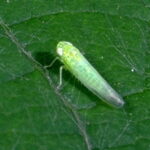Leafhopper and ECB damage increasing: Maintain terminal growth of newly planted trees.

This insect can contribute to shoot blight in years when wind borne Erwina innoculum is present.
Scout for potato leafhoppers and treat when populations approach 1 per leaf. A low rate (0.5 oz. /100 gal.) of Provado (or other neo-nics such as Assail and Calypso) applied on a 7d schedule during the summer will control damage from the feeding of this pest.
European corn borer (ECB): adults continue the summer flight with high pheromone trap captures in New Paltz in mid-June. Extension growth of young tree terminal shoots are susceptible to ECB infestations, especially if tall weeds and grasses in tree rows are present. Hot dry weather fosters high population survival. Although infestations of ECB are unpredictable, infestations can cause serious damage in blocks with no prior incidence of injury. ECB injury is most often seen in young or newly planted orchards that receive low levels of insect pest management. Injury to newly planted trees by larval tunneling occurs in the current season’s growth that results in terminal leaf discoloration. Continued larval feeding will eventually kill the terminal shoot, causing die-back and malformation of the tree. Corn borer attack on young trees can occur from June through August. Fruit feeding can also occur late in the season through harvest. Delegate 25WG and Dipel 10.3DF are labeled for ECB management, and when used for OBLR management, these products will also control ECB infestations at the onset of hatch and feeding.


